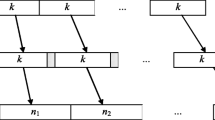Abstract
The major challenge with multimedia communication lies in the demand for higher data rates with better quality of service and lower latency over the wireless channel. Multimedia content is usually source encoded with variable length codes (VLCs) for optimizing bandwidth utilization. VLCs, even though uniquely decodable, suffer from the problem of error propagation. A single bit error can cause an entire block of data to be decoded wrongly, because the ending of a codeword and the beginning of the next can no longer be determined correctly. Several joint source-channel coding (JSCC) techniques are studied in literature to have efficient source coding with resilience to channel errors, but such methods pose a prohibitively high computational complexity. A variant of JSCC for efficient transmission of information is presented in this paper. The information text is encoded by reversible VLC (RVLC) and corresponding to it, a header sequence is generated. Since the headers are critical in decoding a block, they are channel coded with convolution code to protect from errors. Orthogonal frequency division multiplexing is used to provide high data rate communication and robustness to multipath fading. The performance of the system is analysed over Rayleigh fading channel in terms letter error rate (LER) and computational complexity. The proposed method is seen to provide a good LER performance at moderate to high signal to noise ratio, along with minimal computational complexity, when compared with the contemporary JSCC based schemes. Theoretical performance bounds for the error rate of the proposed system are also derived.




Similar content being viewed by others
References
Takishima, Y., Wada, M., & Murakami, H. (1995). Reversible variable length codes. IEEE Transactions on Communications, 43, 158–162.
Tsai, C. W., & Wu, J. L. (2001). On constructing the Huffman-code-based reversible variable length codes. IEEE Transactions on Communications, 40(9), 1506–1509.
Tseng, H.-W., & Chang, C.-C. (2003). Construction of symmetrical reversible variable length codes using backtracking. The Computer Journal, 46(1), 100–105.
Lin, C., Chuang, Y., & Wu, J. (2002). Generic construction algorithms for symmetric and asymmetric RVLCs. In Proceedings of the IEEE international conference on computational science (ICCS), The Netherlands, April (pp. 968–972).
Goel, R., & Gupta, R. (2014). Redesigning of the construction of symmetrical RVLCS based on graph model. International Journal of Information & Computation Technology, 4(11), 1063–1068.
Kliewer, J., & Thobaben, R. (2005). Iterative joint source-channel decoding of variable length codes using residual source redundancy. IEEE Transactions on Wireless Communications, 4(3), 919–929.
Yin, L., Lu, J., & Wu, Y. (2002). LDPC-based joint source-channel scheme for multimedia communication. In The 8th IEEE international conference on communication systems (ICCS-2002) (Vol. 1, pp. 337–341).
Grangetto, M., Cosman, P., & Olmo, G. (2005). Joint source/channel coding and MAP decoding of arithmetic codes. IEEE Transactions on Communications, 53(6), 1007–1016.
Liu, F., Ho, P., & Cuperman, V. (1993). Joint source and channel coding using a non-linear receiver over Rayleigh fading channel. In Proceedings of the IEEE communication theory mini-conference, Houston, USA (pp. 1–6).
Ho, K.-P., & Kahn, J. M. (1995). Combined source-channel coding using multicarrier modulation. In Proceedings of 29th IEEE-ASILOMAR conference (pp. 7–9).
Gabay, A., Rioul, O., & Duhamel, P. (2001). Joint source and channel coding using structured oversampled filters banks applied to image transmission. In IEEE international conference on acoustics, speech, and signal processing, 2001 (ICASSP 2001) (Vol. 4, pp. 2581–2584).
Lin, Zihuai, & Aulin, Tor. (2005). Joint source and channel coding using TCQ/CPM: Iterative decoding. IEEE Transactions on Communications, 53(12), 1991–1995.
Xiao, J.-J., Luo, Z.-Q., & Jindal, N. (2006). Linear joint source-channel coding for Gaussian sources through fading channels. In IEEE Global communications conference, San Francisco, CA (pp. 1–5).
Redmill, D. W., & Kingsbury, N. G. (1996). The EREC: An error resilient technique for coding variable length blocks of data. IEEE Transactions on Image Processing, 5, 565–574.
Fang, Y. (2010). EREC-based length coding of variable-length data blocks. IEEE Transactions on Circuits and Systems for Video Technology, 20(10), 1358–1366.
Dayanand, S. S., & Poddar, P. G. (2015). A simplified approach for joint source and channel coding for data transmission over the fading channel. In IEEE international advanced computing conference IACC 2015 (pp. 1067–1071).
Lin, S., & Costello, D. J., Jr. (1983). Error control coding—Fundamentals and applications. Englewood Cliffs, NJ: Prentice Hall Inc.
Proakis, J. G. (2000). Digital communications (4th ed.). New York: McGraw-Hill Higher Education.
Author information
Authors and Affiliations
Corresponding author
Rights and permissions
About this article
Cite this article
Poddar, P.G., Dayanand, S.S. A Simplified Joint Source and Channel Coding System for Data Transmission over Fading Channel. Wireless Pers Commun 94, 1341–1358 (2017). https://doi.org/10.1007/s11277-016-3685-y
Published:
Issue Date:
DOI: https://doi.org/10.1007/s11277-016-3685-y




